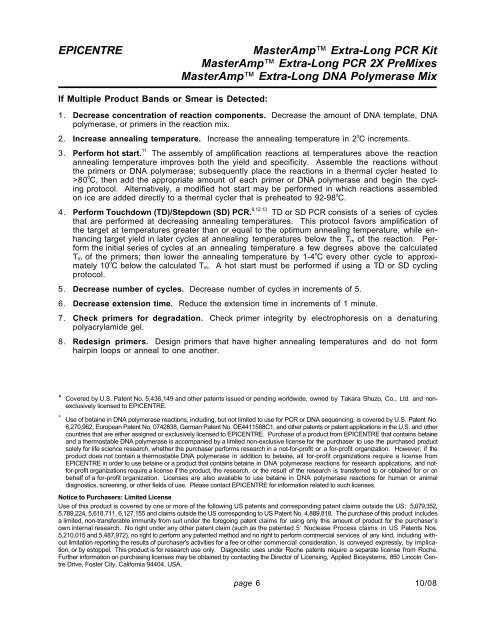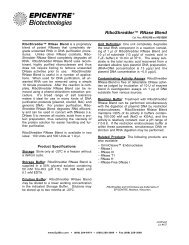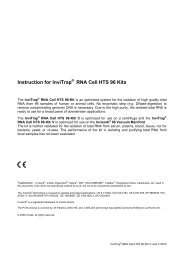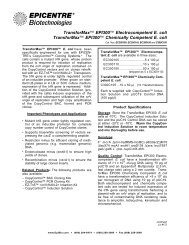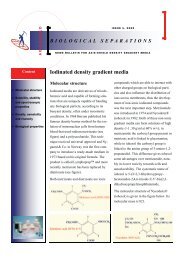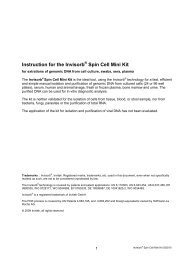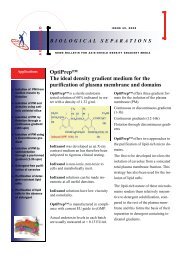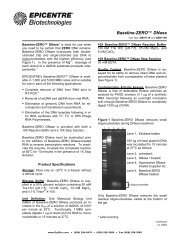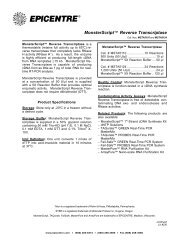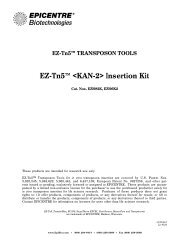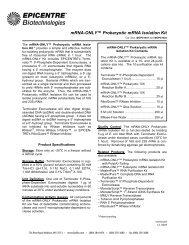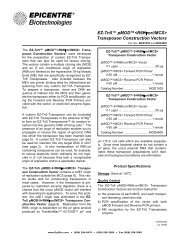Protocol for MasterAmp™ Extra-Long PCR Kit, MasterAmp™ Extra ...
Protocol for MasterAmp™ Extra-Long PCR Kit, MasterAmp™ Extra ...
Protocol for MasterAmp™ Extra-Long PCR Kit, MasterAmp™ Extra ...
- No tags were found...
Create successful ePaper yourself
Turn your PDF publications into a flip-book with our unique Google optimized e-Paper software.
EPICENTREMasterAmp <strong>Extra</strong>-<strong>Long</strong> <strong>PCR</strong> <strong>Kit</strong>MasterAmp <strong>Extra</strong>-<strong>Long</strong> <strong>PCR</strong> 2X PreMixesMasterAmp <strong>Extra</strong>-<strong>Long</strong> DNA Polymerase MixIf Multiple Product Bands or Smear is Detected:1. Decrease concentration of reaction components. Decrease the amount of DNA template, DNApolymerase, or primers in the reaction mix.2. Increase annealing temperature. Increase the annealing temperature in 2 o C increments.3. Per<strong>for</strong>m hot start. 11 The assembly of amplification reactions at temperatures above the reactionannealing temperature improves both the yield and specificity. Assemble the reactions withoutthe primers or DNA polymerase; subsequently place the reactions in a thermal cycler heated to>80 o C, then add the appropriate amount of each primer or DNA polymerase and begin the cyclingprotocol. Alternatively, a modified hot start may be per<strong>for</strong>med in which reactions assembledon ice are added directly to a thermal cycler that is preheated to 92-98 o C.4. Per<strong>for</strong>m Touchdown (TD)/Stepdown (SD) <strong>PCR</strong>. 8,12,13 TD or SD <strong>PCR</strong> consists of a series of cyclesthat are per<strong>for</strong>med at decreasing annealing temperatures. This protocol favors amplification ofthe target at temperatures greater than or equal to the optimum annealing temperature, while enhancingtarget yield in later cycles at annealing temperatures below the T m of the reaction. Per<strong>for</strong>mthe initial series of cycles at an annealing temperature a few degrees above the calculatedT m of the primers; then lower the annealing temperature by 1-4 o C every other cycle to approximately10 o C below the calculated T m . A hot start must be per<strong>for</strong>med if using a TD or SD cyclingprotocol.5. Decrease number of cycles. Decrease number of cycles in increments of 5.6. Decrease extension time. Reduce the extension time in increments of 1 minute.7. Check primers <strong>for</strong> degradation. Check primer integrity by electrophoresis on a denaturingpolyacrylamide gel.8. Redesign primers. Design primers that have higher annealing temperatures and do not <strong>for</strong>mhairpin loops or anneal to one another.* Covered by U.S. Patent No. 5,436,149 and other patents issued or pending worldwide, owned by Takara Shuzo, Co., Ltd. and nonexclusivelylicensed to EPICENTRE.+ Use of betaine in DNA polymerase reactions, including, but not limited to use <strong>for</strong> <strong>PCR</strong> or DNA sequencing, is covered by U.S. Patent No.6,270,962, European Patent No. 0742838, German Patent No. DE4411588C1, and other patents or patent applications in the U.S. and othercountries that are either assigned or exclusively licensed to EPICENTRE. Purchase of a product from EPICENTRE that contains betaineand a thermostable DNA polymerase is accompanied by a limited non-exclusive license <strong>for</strong> the purchaser to use the purchased productsolely <strong>for</strong> life science research, whether the purchaser per<strong>for</strong>ms research in a not-<strong>for</strong>-profit or a <strong>for</strong>-profit organization. However, if theproduct does not contain a thermostable DNA polymerase in addition to betaine, all <strong>for</strong>-profit organizations require a license fromEPICENTRE in order to use betaine or a product that contains betaine in DNA polymerase reactions <strong>for</strong> research applications, and not<strong>for</strong>-profitorganizations require a license if the product, the research, or the result of the research is transferred to or obtained <strong>for</strong> or onbehalf of a <strong>for</strong>-profit organization. Licenses are also available to use betaine in DNA polymerase reactions <strong>for</strong> human or animaldiagnostics, screening, or other fields of use. Please contact EPICENTRE <strong>for</strong> in<strong>for</strong>mation related to such licenses.Notice to Purchasers: Limited LicenseUse of this product is covered by one or more of the following US patents and corresponding patent claims outside the US: 5,079,352,5,789,224, 5,618,711, 6,127,155 and claims outside the US corresponding to US Patent No. 4,889,818. The purchase of this product includesa limited, non-transferable immunity from suit under the <strong>for</strong>egoing patent claims <strong>for</strong> using only this amount of product <strong>for</strong> the purchaser’sown internal research. No right under any other patent claim (such as the patented 5’ Nuclease Process claims in US Patents Nos.5,210,015 and 5,487,972), no right to per<strong>for</strong>m any patented method and no right to per<strong>for</strong>m commercial services of any kind, including withoutlimitation reporting the results of purchaser's activities <strong>for</strong> a fee or other commercial consideration, is conveyed expressly, by implication,or by estoppel. This product is <strong>for</strong> research use only. Diagnostic uses under Roche patents require a separate license from Roche.Further in<strong>for</strong>mation on purchasing licenses may be obtained by contacting the Director of Licensing, Applied Biosystems, 850 Lincoln CentreDrive, Foster City, Cali<strong>for</strong>nia 94404, USA.page 6 10/08


